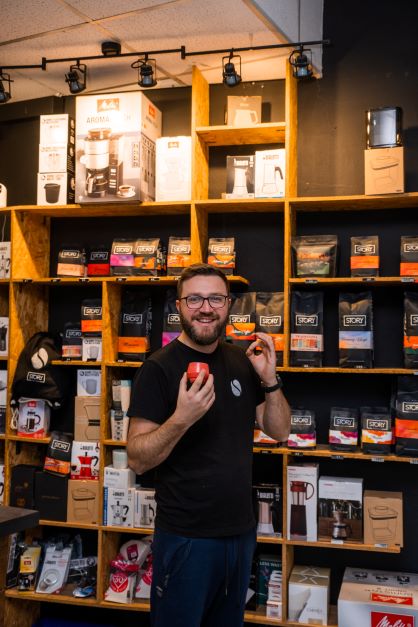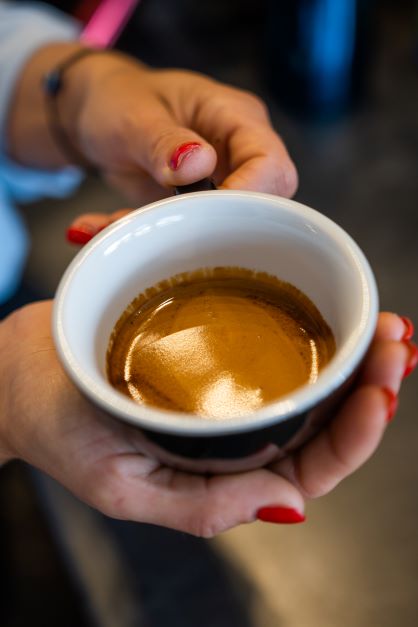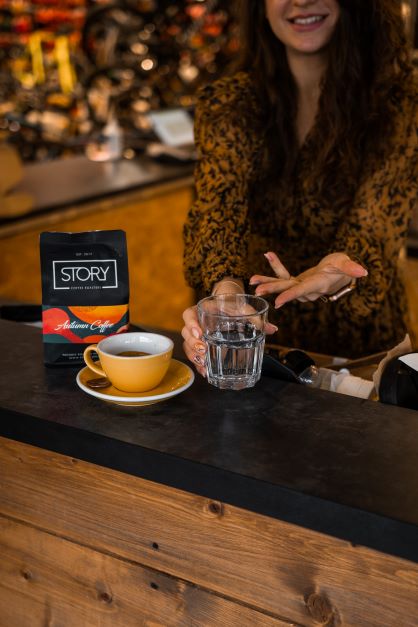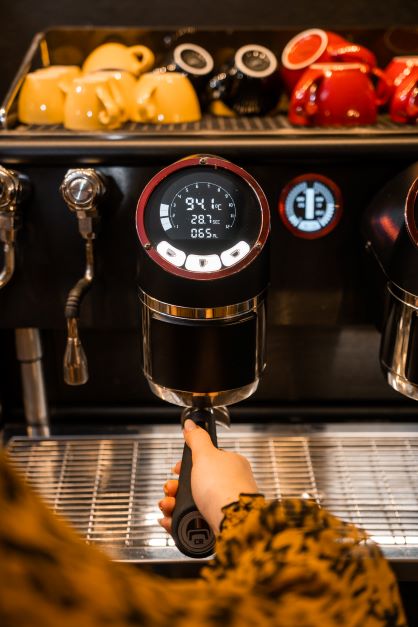
Espresso ah espresso! Can you smell the aroma and taste it! If so and your salivary glands are stimulated then
means you've had a delicious, well-brewed espresso at least once in your life!

In this post, I'd like to give you a bit of an introduction to espresso, what it is and how it has changed on the
over the years from my perspective.
I remember like today when I 'brewed' my first espresso. I was working at the time in a sunny
Italy, in Bari to be precise. The barista fell ill and could not come, Vito the owner of the café in which the
I was working and he asked if I would make him a coffee. Coffee, because you know that coffee is espresso, but
back on topic. Will I make the coffee! Ba, after all, what's so difficult about it, after all, it's already been a while
I stood behind the bar and helped out, I saw how it was done, so I got straight down to work,
I detach the flask from the coffee machine, approach the grinder with the chamber (container for ground coffee,
At that time there were still no such miracles as grinding on demand) I moved the "lever" twice
I hook the flask up to the group, press start on our La Cimbali M39 dosatron with the word
triumph on my face that I finally brewed the coffee myself!
Well, unfortunately! To my surprise the coffee was almost everywhere just not in the cups.... f**k something
went wrong! But how?
Then Vito walks up with a smile on his face and says "What, you forgot to whip the coffee and it's too weak
have you hooked up a flask?" 🙂 .
He calmly showed me what and how. And "tamper" is written in inverted commas because it's hard in retrospect
That's what you call it, what was next to that container for ground coffee. That's probably why he didn't
found.
And this is what my first espresso brewing looked like.
Later, after just a few days of diligent study under the tutelage of several baristas, I knew how to set the grinder to make the espresso brew, just as the Istituto Espresso Italiano Certificato says about it.
That is, for a 50-100ml espresso cup. Prepare with 7g +/- 0.5g of ground coffee,
25ml +/- 2.5ml of coffee, covered in a hazelnut-coloured crema in 25sec +/- 5 seconds with a
darker spots (so-called Tiger skin).

Aroma Intense and rich with notes of flowers, fruit, chocolate and baked bread. In the mouth
The espresso should be full-bodied and velvety, slightly bitter but never astringent. A
the water temperature at the outlet of the group should be 88 degrees Celsius with a permissible
fluctuation of 2 degrees. And then there is the pressure at the pump of 9 bar +/- 1 bar. Of course, we did not use
scales or stopwatches. We did it with a precise eye. Espresso can't go too fast
fall, there must be a mouse tail, etc. Well, and steam those plus or minus 25 seconds.
On top of that, I learned to froth the milk well (fortunately not for a mole mound, but for yoghurt cream) and I could also make certified Italian cappuccino,but about that maybe another time. Here, let's focus on espresso.
One other important thing I learned was to work quickly and in an organised manner behind the bar, for
before I knew the word casino, equivalent to the word 'snuff' in our language.
The most important thing, however, was to properly accommodate our guests, i.e. the customer
service.
Now let's get back to our espresso, because here too I learnt about the 4M principle, in fact already 5M.
- La macchina - the machine
- Macinatore - mill
- Miscela - coffee blend
- La mano - hand / barista
- Manutenzione - conservation
And so knowing all the ins and outs of Italian espresso, and drinking it in countless quantities and places,
Having lived there for almost five years, it was time to return to the country.
When I came back and saw one of the cafes it was a natural to go in for an espresso.
Unfortunately, it was not the most pleasant espresso to greet me on my return to Poland, immediately
The thought occurred to me that I probably wouldn't return a good espresso here. Fortunately, I was wrong.
Fate would have it that I ended up again in a café with people who liked what they were doing,
and above all they liked coffee! Luke with whom I had the longest job interview of my life,
but at the same time the best one showed me that it was possible to paint on coffee, met people connected with
coffee scene in Poland and so I started to rediscover coffee!
The first step was to drink an espresso, which tasted completely different from all coffees,
Which I have drunk so far. It was surprisingly sweet, fruity and full-bodied. It was an Ethiopia Amaro Gayo
from natural processing, the coffee was also lighter roasted. I also took off on this coffee later in the
qualifiers for the Polish Barista Championships, but about that maybe in a separate entry, because it can
seem simple looking at it from the sidelines... This is a really demanding competition,
I will just say that the regulations themselves are 48 pages long and it is good to read them with understanding, which I myself
I didn't do then.

But let's get back to our espresso.
The espresso I have known until now has changed. It has changed its taste, it has changed the way
preparation and attention to detail during its preparation. I have written to you above about
certified Italian espresso and its parameters. Now let's look at the parameters of the espresso,
which are stated in the regulations of the World Barista Championship under the auspices of Specialty Coffee
Assosation
- Espresso volume 30ml +/- 5ml
- Water temperature 90.5-96 C
- Pressure 8.5-9-5 bar
- Brewing time 20-30 seconds (recommended but not required)
Modern espresso is prepared with homogenous or blends of homogenous high coffee
quality. That is, those defined as Specialty coffees that score 80+ points (about this in the
another entry). The coffee is roasted light to medium so as to maintain its natural profile
sensory. Therefore, the temperature recommended by the SCA is higher than that recommended by the Italian Institute.
Lighter roasted coffee beans need a higher water temperature and ensure adequate coffee extraction.
A good Barista, like a good Cook, will prepare his espresso according to the recipe he
prepared in advance and adapted to the beans it has in the grinder, so that the attributes of the espresso are
the best possible quality.
- Aroma (perceptible through the nose)
- Taste balance (sour, sweet, bitter)
- Flavour (taste, aroma and texture)
- Body / Texture
- Aftertaste (length and intensity)
The barista, with the help of his working tools, apart from the obvious ones like the coffee machine and the grinder, will use the
dispenser to ensure even distribution of the coffee in the baskets (portafilter sieve) which
with proper and even tampering will ensure even extraction and prevent
channeling. He will also use a scale to help him build his recipe.
And what is a recipe? A recipe is a dry and wet mass over time.
An example of the recipe I always go with:
- 18g ground coffee
- 36-38g yield (infusion per cup)
- In 27-30 seconds
The recipe and weighting allow for repeatability.
Why the weight and not the number of ml? Because fresh coffee and strong decaffeinated coffee will be different
is the amount of aerated crema in an espresso. This depends on the Co2 content of the coffee and the
from the origin of the grain itself. For example, beans from Ethiopia will have less crema than beans
roasted on the same day from coffee originating in Indonesia. Here, too, is my suggestion for
freshness of the coffee.Fresh coffee is great and we all like it, but if you want to enjoy the full flavour of espresso, don't brew super freshly roasted coffee. Freshly roasted coffee contains a great deal of dioxide
carbon dioxide, of which there is a great deal during the first two weeks. Excess carbon dioxide
obscures some of the attributes of espresso and, in my opinion, the most important ones which are
sweetness and texture.
This is what it looks like from my observations working in a roastery for several years and being exposed to fresh coffee
on a daily basis. So what is the best time to start brewing espresso from the roast date? Not
I will answer this question unequivocally, as it will depend on what kind of coffee it is and how quickly it was packed after roasting.
In contrast, the optimum will be 2-3 weeks after smoking, and some may reach their tz.
Sweet spot even after a month. Does that mean it can't be brewed when it's fresh? It can,
we can grind the coffee and wait 10 minutes to get rid of some carbon dioxide,
But even so, the coffee will not show its full potential. Besides, with coffee that is too fresh, a lot of
easier to channel, which can lead to under-roasted espresso.
In summary, espresso and our approach to it has changed over the years.
We are able to extract even more flavour and aroma from it to make the day even more
better!
Product categories: